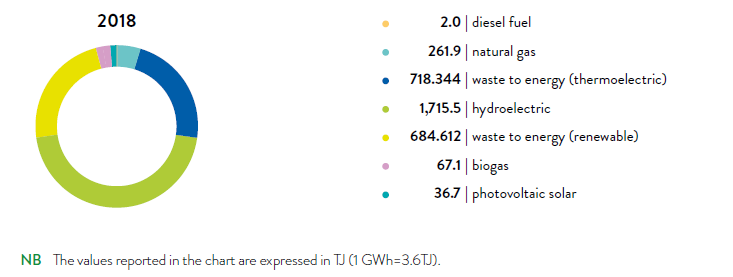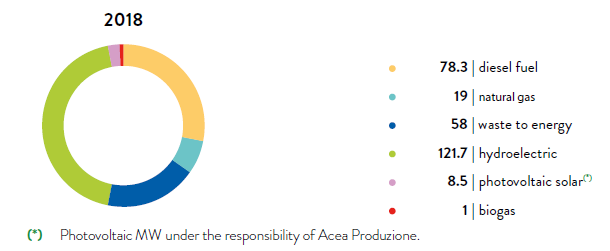Energy production
Group plants
Acea produces electricity mainly through hydroelectric plants; a significant share is produced by waste-to-energy of pulpers and Secondary Solid Fuel - CSS, a primary energy source derived from waste and partly renewable.
The generation from hydroelectric sources (renewable) and thermoelectric from fossil sources – this latter principally by means of a high-efficiency cogeneration plant, renovated in 2017 – is entrusted to Acea Produzione; the inventory of generators available to the company is comprised by:
- 7 hydroelectric power stations located in the Lazio and Abruzzo regions (122 MW);
- 2 thermoelectric power stations located in the territory of the Municipality of Rome: Montemartini (78.3 MW) and Tor Di Valle (19.0 MW) 107, for 97.3 MWe total installed power available.
Electricity produced
In 2018 total gross electricity production was about 968 GWh, up on the previous year (+16% compared to 838 GWh in 2017). The increase in production is due mainly to the full operation of the new CAR module in Tor di Valle and to the hydroelectric contribution (the latter +25%).
The share of electricity generated by renewable sources, about 696 GWh, has proven to be clearly predominant and equal to about 72% of the total, with the following contributions:
- 477 GWh from hydroelectric power;
- 190 GWh from waste-to-energy;
- 19 GWh from biogas (Orvieto plant);
- 10 GWh from solar panels (see Chart no. 42 and Table no. 49).
With regard to the share of green energy from waste to energy, about 49% of the production from this type of plant is renewable, being associated to the combustion of the biodegradable fraction of waste used as a primary source. In particular, the renewable share of the fuel (RDF) entering the San Vittore del Lazio plant proves to be equal to 51% of the total of waste to energy, while in the Terni plant this share proves to be around 42%.
CHART NO. 42 - ELECTRICITY PRODUCED SUBDIVIDED BY PRIMARY ENERGY SOURCE (TJ) (2018)

[107] The Tor Di Valle power station, historically constituted by a cogeneration plant (19.3 MW) and a combined cycle plant (126 MW), has taken the combined cycle plant out of action, whilst it has renovated the cogeneration plant. Today Tor di Valle consists of a single High Yield Cogeneration (CAR) plant, which has been in operation progressively since 2017. 2018 is therefore the first year in which it has been operating at full capacity for a full 12 months.
Thermal energy produced
During 2018 Acea Produzione continued the project of extending the district heating network of Mezzocammino district in the zone South of Rome was pursued.
After completion of the modernisation project, the Tor di Valle thermoelectric power plant generated about 98 GWh of thermal energy.
The new plant, equipped with two high efficiency internal combustion engines of 9.5 MW each, earned CAR qualification from the GSE.
The heat generated was used to serve a basin of about 39,370 inhabitants in the zone South of Rome (Mostacciano, Torrino, as well as the cited Mezzocammino) by means of a district heating network which sever a volume equal to about 3,590,632 cubic metres.
TABLE NO. 47 - GROSS HEAT PRODUCED BY THE TOR DI VALLE POWER STATION (2016-2018)
| gross heat produced (kWht) | 2016 | 2017 | 2018 |
| Tor di Valle thermoelectric power station | 90,027,823 | 96,187,780 | 98,375,640 |
| CAR module (operational since September 2017) | n.a. | 34,917,430 | 98,375,640 |
| Gas Turbine Group in Cogeneration (January-August 2017) | 13,172,350 | 11,946,893 (*) | 0 |
| Auxiliary furnaces (Galleri) (January-August 2017) | 76,855,473 | 49,323,157 (*) | 0 |
(*) The old plant was in production up until August 2017. The data is relative to the period January - August 2017. In 2018 the plant only operated as a CAR plant.
[108] The total installed power includes the Acea Produzione plants, the waste-to-energy plants and the Orvieto plant (Acea Ambiente) for the production of biogas.
Acea Produzione has continued to modernise and improve the efficiency of its hydroelectric plants: after work carried out in previous years at the Guglielmo Marconi, Salisano and Alessandro Volta power plants, in 2018 revamping work
continued on the Galileo Ferraris hydroelectric plant in Mandela, also in the province of Rome.
The set of works will allow, on the basis of the condition of power installed and authorised in concession, the use of the available water resource to be optimised.
TABLE NO. 48 - THE ELECTRIC POWER STATIONS OF ACEA PRODUZIONE
| hydroelectric power stations | thermoelectric power stations |
| Castel Madama Power Station (Rome) gross power 9.4 MW | Tor di Valle Power Station: high efficiency cogeneration section (CAR)(*) (Rome) methane fuel - gross power 19.0 MW |
| G. Ferraris power plant in Mandela (Rome) gross power 8.5 MW | Montemartini (Rome) power plant diesel fuel - gross power 78.3 MW |
| Salisano (Rieti) power plant gross power 24.6 MW | |
| G. Marconi power plant in Orte (Viterbo) gross power 20.0 MW | |
| Sant’Angelo (Chieti) power plant gross power 58.4 MW | |
| Cecchina (Rome) power plant gross power 0.4 MW | |
| Madonna del Rosario (Rome) power plant gross power 0.4 MW | |
| GENERAL TOTAL: GROSS CAPACITY 219 MW | |
(*) The CAR plant in Tor Di Valle, which has replaced the old cogeneration and combined cycle sections, provides district heating service in the area south of Rome.
The installed capacities, which overall amount to about 287 MW 108 are represented in Chart no. 43, distinguished by energy source.
CHART NO. 43 - INSTALLED ELECTRICAL POWER OF THE GROUP SUBDIVIDED BY ENERGY SOURCE (MW) (2018)

Acea Produzione has continued to modernise and improve the efficiency of its hydroelectric plants: after work carried out in previous years at the Guglielmo Marconi, Salisano and Alessandro Volta power plants, in 2018 revamping work
continued on the Galileo Ferraris hydroelectric plant in Mandela, also in the province of Rome.
The set of works will allow, on the basis of the condition of power installed and authorised in concession, the use of the available water resource to be optimised.
TABLE NO. 49 - ELECTRICITY PRODUCED (BY PRIMARY ENERGY SOURCE) (2016-2018)
| primary energy source | 2016 | 2017 | 2018 |
| TJ (GWh) (*) | |||
| ELECTRICITY PRODUCED (BY PRIMARY ENERGY SOURCE) | |||
| diesel fuel | 4.3 (1.2) | 7.7 (2.2) | 2.0 (0.6) |
| natural gas (cogeneration) | 32.0 (8.9) | 135.2 (37.6) | 261.9 (72.8) |
| waste to energy (for 2018: about 51% of the total) | 562.3 (156.2) | 682.9 (189.7) | 718.4 (199.5) |
| total thermoelectric | 601.9 (167.2) | 825.8 (229.4) | 982.3 (272.9) |
| hydroelectric | 1,402.8 (389.7) | 1,369.7 (380.5) | 1,715.5 (476.5) |
| waste to energy (for 2018: about 49% of the total) | 613.8 (170.5) | 700.2 (194.5) | 684.6 (190.2) |
| biogas | 59.8 (16.6) | 78.7 (21.9) | 67.1 (18.6) |
| photovoltaic solar (**) | 39.2 (10.9) | 41.7 (11.6) | 36.7 (10.2) |
| total renewables | 2,115.7 (587.7) | 2,190.4 (608.4) | 2,503.9 (695.5) |
| general total | 2,717.6 (754.9) | 3,016.4 (837.9) | 3,486.2 (968.4) |
(*) 1 GWh = 3.6 TJ.
(**) Photovoltaic includes the production at the plants of the water area (Acea Ato 2) and at the waste management plant of Orvieto, for a total of 1.5 GWh produced.
The increase in the energy produced by hydroelectric power plants, equal to about 25% compared to 2017, is mainly due to the higher rainfall recorded during the year and to the fact that most hydroelectric power plants have now been revamped and are working better.
As mentioned earlier, the increase in production of thermoelectric power is due to the commissioning of the Tor di Valle power plant. Moreover, its modernisation has optimised the process and has made it possible to reduce consumption and
emissions. In fact, while the thermoelectric energy produced increased by 94%, consumption of natural gas increased by only 34% and carbon dioxide emissions by 27%.